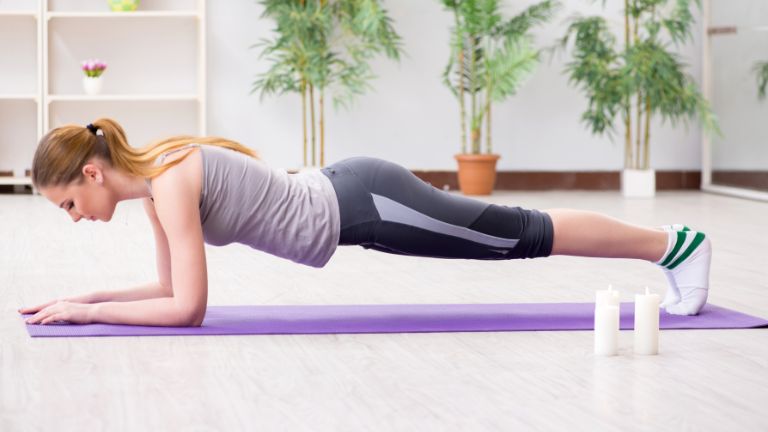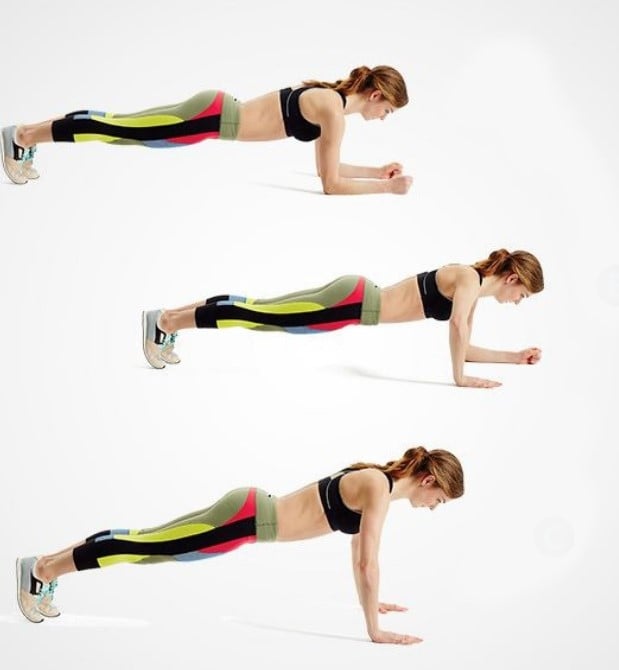A plank walk, also known as a walking plank, is a dynamic variation of the traditional plank exercise.
Why plank walk is so important? This unique bodyweight exercise builds core stability in your abs, obliques, lower back, and beyond. It is an excellent low-impact exercise that can be done anywhere to build core strength.
Unlike stationary planks, plank walks require you to engage your core dynamically as you switch from a high plank position to a low plank position and back again.
When you do the plank walk, your shoulders and upper body muscles, like your deltoids, pectorals, and triceps, are tested.
One aspect I especially appreciate about plank walks is their scalability. You can continuously challenge yourself by adjusting factors such as step distance, speed, or resistance.
Use our free calculator to know your weight loss calories requirement.

Plank Walk Muscles Worked
The plank walk is a compound exercise that engages multiple muscle groups simultaneously. This makes it a highly effective workout that targets both the upper and the lower body.

Core Muscles Worked
- Rectus Abdominis: This is your “six-pack” muscle. It is engaged to keep your body in a straight line.
- Obliques: help with rotational stability and lateral movement.
- Transverse Abdominis helps stabilize your core by pulling your belly in.
Upper Body Muscles
- Shoulder and arm muscles support the upper body and assist in movement.
- Serratus Anterior helps with the stability of your shoulder blades.
- Latissimus Dorsi engaged during the walking phase to stabilize your torso.
- Rhomboids and Trapezius are engaged to keep your back straight and shoulders in place.
Lower Body Muscles
- Glutes are engaged to keep your hips level and assist in walking.
- Quadriceps help keep your legs straight and lift your feet off the ground.
- The hamstrings assist the quadriceps in leg movement.
- Calves, Feet, and Ankle muscles: While not primary movers in the plank walk, these muscles contribute to maintaining balance and stability.
How To Do Plank Walk

- Start in a low plank position with your forearms on the ground.
- Your body should form a straight line from your head to your heels.
- Your feet should be hip-width apart, with your weight supported on your toes.
- Shift your weight onto your left hand as you step your right hand forward.
- Shift your weight to your right hand and step your left hand forward to meet your right. You should know in a high plank position.
- Time to reverse it. Step that left hand back where it started, then follow with the right.
- Keep this up-down dance going for as long as you can handle it. Do 3–4 Sets.
- Take a 30-second to 1-minute break between sets.
To Stay Motivated: 150+ Gym Workout Motivational Quotes To Stay Fit
Walking Plank Tips and Proper Form
- Do not let your lower back sag or your butt rise. Ensure your body is straight and rigid.
- Keep your glutes and core muscles contracted.
- Place your hands directly under your shoulders. This helps to distribute weight evenly.
- If you’re new to Plank Walk, start with a basic plank exercise to build strength and proper form.
- Move your hands smoothly to keep them stable and avoid sudden movements.
- Your neck should be in line with your body, not tilted up, which could strain the neck. Keep your gaze down at the floor.
- Beginners, try holding the plank position for 10-20 seconds. Over time, work up to 30, 45, or 60 seconds.
- Don’t focus too much on the stopwatch, quality trumps the quantity. When your form begins to suffer, it is time to give up.
- Although it’s important to concentrate on perfect form, don’t forget to breathe, as lack of oxygen can cause dizziness or nausea.

Advanced Variations and Modifications
After mastering the fundamental plank walk, it may be worthwhile to experiment with more advanced variations.
- Knee Plank Walk: If you find the traditional plank walk challenging, try doing a knee plank walk to make your core and upper body work less.
- Plank Walk with Push-Up: Perform a push-up each time you return to the plank position. This engages your chest and triceps more intensively.
- Plank Walk to Side Plank: Add a side plank rotation after each plank walk. This will enhance oblique engagement and balance and coordination.
- Weighted Plank Walk: Use a weighted vest to increase resistance.
- Plank Walk with Leg Lift: Incorporate a leg lift at the end of each walk to engage the glutes and lower back.
- Plank Walk with Mountain Climbers: To increase the cardiovascular component, add a set of mountain climbers every time you return to the plank position.

Manish is a NASM-certified fitness and nutrition coach with over 10 years of experience in weight lifting and fat loss fitness coaching. He specializes in gym-based training and has a lot of knowledge about exercise, lifting technique, biomechanics, and more.
Through “Fit Life Regime,” he generously shares the insights he’s gained over a decade in the field. His goal is to equip others with the knowledge to start their own fitness journey.
